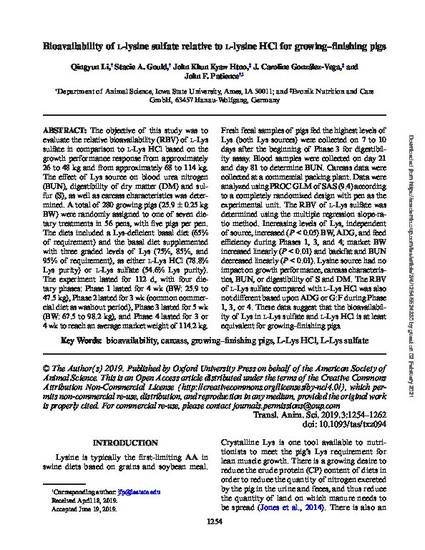
The objective of this study was to evaluate the relative bioavailability (RBV) of l-Lys sulfate in comparison to l-Lys HCl based on the growth performance response from approximately 26 to 48 kg and from approximately 68 to 114 kg. The effect of Lys source on blood urea nitrogen (BUN), digestibility of dry matter (DM) and sulfur (S), as well as carcass characteristics was determined. A total of 280 growing pigs (25.9 ± 0.25 kg BW) were randomly assigned to one of seven dietary treatments in 56 pens, with five pigs per pen. The diets included a Lys-deficient basal diet (65% of requirement) and the basal diet supplemented with three graded levels of Lys (75%, 85%, and 95% of requirement), as either l-Lys HCl (78.8% Lys purity) or l-Lys sulfate (54.6% Lys purity). The experiment lasted for 112 d, with four dietary phases: Phase 1 lasted for 4 wk (BW: 25.9 to 47.5 kg), Phase 2 lasted for 3 wk (common commercial diet as washout period), Phase 3 lasted for 5 wk (BW: 67.5 to 98.2 kg), and Phase 4 lasted for 3 or 4 wk to reach an average market weight of 114.2 kg. Fresh fecal samples of pigs fed the highest levels of Lys (both Lys sources) were collected on 7 to 10 days after the beginning of Phase 3 for digestibility assay. Blood samples were collected on day 21 and day 81 to determine BUN. Carcass data were collected at a commercial packing plant. Data were analyzed using PROC GLM of SAS (9.4) according to a completely randomized design with pen as the experimental unit. The RBV of l-Lys sulfate was determined using the multiple regression slope-ratio method. Increasing levels of Lys, independent of source, increased (P < 0.05) BW, ADG, and feed efficiency during Phases 1, 3, and 4; market BW increased linearly (P < 0.01) and backfat and BUN decreased linearly (P < 0.01). Lysine source had no impact on growth performance, carcass characteristics, BUN, or digestibility of S and DM. The RBV of l-Lys sulfate compared with l-Lys HCl was also not different based upon ADG or G:F during Phase 1, 3, or 4. These data suggest that the bioavailability of Lys in l-Lys sulfate and l-Lys HCl is at least equivalent for growing–finishing pigs.
Available at: http://works.bepress.com/john-patience/79/

This article is published as Li, Qingyun, Stacie A. Gould, John Khun Kyaw Htoo, J. Caroline González-Vega, and John F. Patience. "Bioavailability of L-lysine sulfate relative to L-lysine HCl for growing–finishing pigs." Translational Animal Science 3, no. 4 (2019): 1254-1262. doi: 10.1093/tas/txz094.